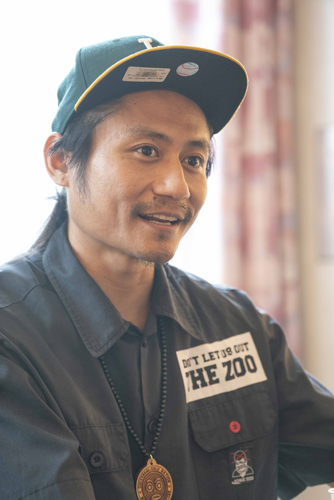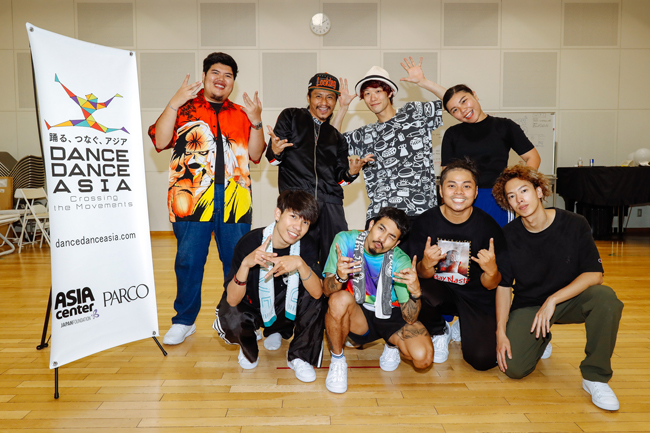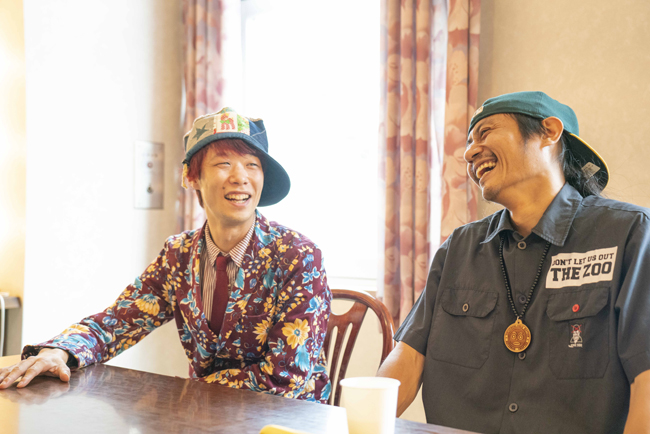Reflecting the individuality of dancers in creations
Suzuki: Going back to Crayon Shin-chan, you might as well summon the genie by simply saying, "Come out, genie!" But I like the fact that there is a dance move in there. I like the way that even though there may be no meaning to the move itself, that it's still meaningful to include the dance. So during rehearsals with Nikii, we often talk about things like, "Why do the characters start dancing in this particular scene?" or "What meaning does that dance have in the context of the overall dramaturgy?" It's really interesting to discuss how a simple dance develops into a dance that bears a meaning in relation to the dramatic interpretation of the piece.
Nikii: Besides, Takuro and I have similar feelings and thoughts. From the very first time we met, I thought, "I can see he's similar to me. He's from the same tribe." We kind of dress alike as well (laughs), so I thought it's definitely going to be fun working with him.

Suzuki: So we don't even need words to know what the other is thinking. Nikii directs the group in such an interesting way that I just have fun thinking to myself why he made or didn't make a certain comment at a certain point.
Nikii: Takuro is very thoughtful and gives me advice without digressing from my theme. When you are involved in creating something, you sometimes want to include your own ideas, but in doing so you can also cause problems. That's not the case with Takuro.
Suzuki: Maybe that's because I always like to say, "Yes, and...." I know what Nikii wants to do and I think it's 100 percent interesting, but I would be of no use if I just nodded and agreed to what he was doing (laughs). So I would like to be the one to make suggestions like, "Why don't you add this?"
Nikii: I am often asked to judge in dance competitions where participants ask me, "How was my dance?" I never criticize them because there is no right or wrong to dance, and I'm judging to help them improve. So you can see how Takuro and I think similarly in that sense too.
Suzuki: Of course, with people who are not sure what to do, I do sometimes ask, "What is it that you want to do?" But in Nikii's case he knows exactly what he wants to do, so I can suggest, "What about doing this to make it more interesting?"
Nikii: But when I was first offered to work on this piece, I couldn't imagine creating a 30-minute dance number using five dancers. I myself was in the middle of a transition period as my contract with the studio that I belonged to was about to finish. But I accepted the offer because I thought it was a challenge for myself that I had to overcome.
Suzuki: But from our very first meeting, Nikii, you never wavered in terms of what you want to do. You've always aimed for the same goal.
Nikii: Is that a good thing?
Suzuki: Of course.
Nikii: Good (laughs). As for the five dancers who are taking part in Inception, I believe that they too have their own personal goals in life, so I would like those goals to be expressed and reflected in their dance. I'm sure each dancer is hoping that he or she makes an impression on the audience, but it would be boring, wouldn't it, if there were five similar people...like five Michael Jacksons (laughs)? I encourage every single dancer to think about what his or her own dance is because what I want to show the audience is each dancer's own dance.

Suzuki: After a few rehearsals I've come to realize that Nikii wants the performance to feature the individual dancers. Through the rehearsals, we are heading towards not only coordinating the five dancers into one but also developing the individualities of each member and then connecting them as a group. We know that the five dancers all love to dance, but their lives consist of other elements as well. Nikii wants to reveal the individualities of the five dancers based on the different lives that they lead. I think that shedding light on the individual could become the key factor in connecting this dance piece to the audience who may not necessarily be dance fans. If they see the personal side of the dancers in what is basically a highly technical program, the audience will feel a sense of affinity and unity with the performers.
Nikii: I agree. There is still a wall between the performers who are standing onstage and the audience who are looking up at the stage. I would like to take down that wall.
Suzuki: That wall is so thick, especially in Japan (wry smile).
Nikii: When I first came to Japan in 2015, the atmosphere of the theater was intimidating, to say the least (wry smile). When I tried hard to make a crack in that wall, the response from the audience was greater than I had expected, so that was nice.
Kosugi: In that respect, from Inception we got the impression that the wall no longer existed because the dancers were facing the audience as individuals.
Suzuki: I think Nikii is aware of that too. It's about paying attention to the audience who are there with you, at that moment.
Nikii: So the five dancers reflect their goals and ideas of happiness in their dance, reaching out to the audience and asking them,"What is happiness for you? What is it that you want to do?" It would be great if something like that happens.
Kosugi: In relation to this project, Suzuki san, you have co-directed A Frame for Shibuya StreetDance Week, Tokyo in 2015. Looking back on your experiences at the time as well, what are your thoughts on DANCE DANCE ASIA as a project?
Suzuki: With A Frame the title was symbolic. There was the theme of boundaries, whether you were going to be caught up in them or not, whether you were going to escape from boundaries or be trapped in them. Paradoxically, whatever country you live in and whether or not you dance, in fact there is not a big difference in what we worry about in everyday life. In that sense we are connected with one another without even thinking about it. So rather than showing people that "It's like this in Thailand but like that in Japan", I think the importance of an international exchange project like this lies in its ability to indicate that the feelings of individuals are not separated by borders. In Inception as well, what is important will probably be how many interesting things the audience, as individuals, can discover in this 30-minute performance.
Nikii: I also believe that it's important to do your job in a relaxed atmosphere, which very often leads to a positive outcome. At first I thought I was given a difficult task when I was asked to create a 30-minute piece, but as we continued our rehearsals in a relaxing environment, we came up with ideas that we wouldn't even be able to fit into 30 minutes. I guess I wouldn't know what to do again if they told me, "Now let's make it 90 minutes." (laughs)
Suzuki: (Laughs). I believe that the atmosphere generated by the company also spreads to the audience. If there's a group of people onstage who don't get along with each other, the audience will feel the bad vibe. So whether or not you have mutual trust within the company is essential. The audience will know if we don't have a smooth channel of communication among ourselves.
Nikii: That's absolutely true. For example there was one dancer who was afraid to use a small stage prop in this performance. At first she wasn't able to use it properly, but we focused on communicating with each other, which helped us to solve the problem pretty quickly.
Kosugi: Finally do you have a message to the audience who are looking forward to DANCE DANCE ASIA in Tokyo 2019?
Nikii: More than anything else we would like you to enjoy our performance. As we said before, we are aiming to create a piece that leaves you thinking afterwards. We hope you are looking forward to seeing us.
Suzuki: Personally I am not dancing in this piece, so instead I would like to learn a skill. There's a certain musical instrument that is used in the performance, so I guess my personal goal would be to learn how to play this instrument (laughs). In the same way, I would be happy if the performance makes you think, "I want to do something too," since inspiring people is one of our themes and what we are aiming at. You see, one of our dancers came to Japan and fell in love with shichimi togarashi, a Japanese blend of seven spices (laughs). So it could really be anything. I hope that people who come to see this performance will take home a souvenir of some sort.

[On April 26, 2019 at a studio in Tokyo]
More Information
DANCE DANCE ASIA―Crossing the Movements Official Website
Interviewer: Atsushi Kosugi
Writer and editor, Kosugi is mainly involved in covering stage performances and editing brochures. He has been working with DANCE DANCE ASIA since 2016, conducting interviews and editing public relations material such as performance brochures.
Photo: Nobuhiko Hikiji






